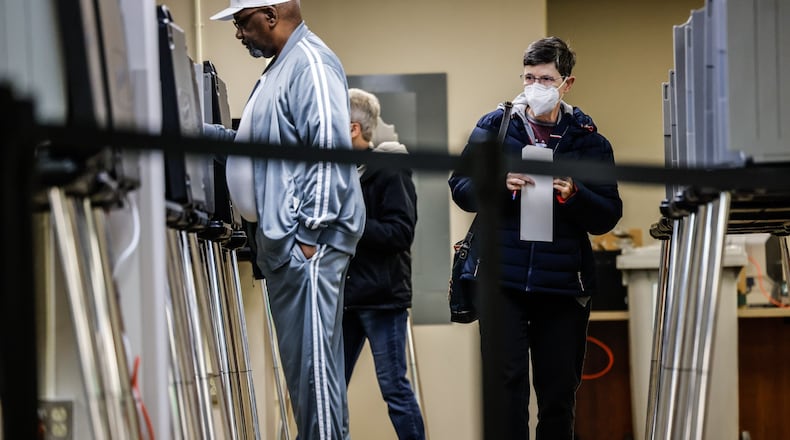Brian Sleeth, Warren County Board of Elections director and president of the Ohio Association of Election Officials, said he expects turnout to reach 15% to 18% of registered voters, once the in-person ballots on Election Day itself are tallied.
“We’re right on par,” he said.
Secretary of State Frank LaRose’s office released early-voting numbers on Monday, showing that three weeks of voting had drawn 100,809 ballots statewide, with more than 80,000 requested absentee ballots still out.
That included 87,693 Democratic ballot requests, 91,365 Republican requests, and 3,438 nonpartisan requests.
In Clark County, just over 3,000 people had cast absentee or early in-person votes as of Thursday, said Amber Lopez, deputy director of the Clark County Board of Elections. More than half of those votes came by mail, and with 1,238 voting early in person.
Credit: Bill Lackey
Credit: Bill Lackey
“So far, absentee turnout is as expected and similar to 2018,” she said.
The 2018 primary saw 3,528 early votes cast in Clark County, with about two-thirds of them from in-person voters. Both of those elections were dwarfed by the 2020 primary, which drew nearly 20,000.
Turnout in Montgomery County has been low, but has picked up in recent days, said Jeff Rezabek, Montgomery County Board of Elections director.
“It is a little lower than what we had thought, but each election cycle is unique,” he said.
A tally from the Ohio Secretary of State’s office showed 1,969 absentee ballots cast in Montgomery County as of this week, with another 1,152 voting in person.
Voting totals are probably a little lower than four years ago in Miami County, but longer voting hours may be keeping it close, said Laura Bruns, Miami County Board of Elections director.
“It’s picked up in the last couple days. I think the 11-hour days help,” she said.
Bruns’ office has recorded 1,052 in-person and 421 mail-in votes. Miami County has about 75,000 registered voters.
“So we’re almost to 2%,” she said. “I expected that we would be up in the 20s. I’m not really sure we’re going to hit that, to be honest.”
Warren County election officials have seen 1,350 in-person voters and received 2,380 by mail as of Wednesday, Sleeth said. That puts the county on track to meet or slightly surpass the 21% turnout for the 2018 primary, he said.
Ballots include primaries for all statewide offices, U.S. House and Senate seats, local judicial and municipal offices, and local tax issues.
Due to the ongoing legal fight over state legislative district maps, seats in the Ohio House, Ohio Senate and the central committees of both major political parties will not be on the May 3 ballot.
A second primary must be held for those. It has yet to be scheduled, but is expected to be Aug. 2, when some local tax levies are already on the ballot. Holding a second statewide primary is estimated to cost $25 million to $30 million.
According to estimates submitted to the Ohio secretary of state’s office, costs in Montgomery County would likely be at least $432,500; in Butler County, $350,000; and in Warren County $250,000.
Election officials said people are asking lots of questions about that second primary, but uncertainty doesn’t seem to be keeping voters away.
“I do not believe that the omission of the state House and Senate, and State Central Committee races is affecting turnout,” Rezabek said in an email. “When we do get calls asking if we have an election, we let them know that we are and give all the dates of early voting, absentee information and election day information. I do not see that the voter is confused; most are wondering when the next primary will be.”
The most contentious race on the May 3 ballot is the seven-way Republican primary for the U.S. Senate seat now held by U.S. Sen. Rob Portman, R-Ohio, who is not seeking reelection. That doesn’t seem to have heavily affected turnout either, area election officials said.
But in Miami County, many voters are in for a surprise: learning they’re now in the 15th Congressional District, Bruns said. Miami County has previously been in the 8th district, but the U.S. House district map that will be used this year leaves only the county’s southwestern corner in the 8th, she said.
Rezabek said some polling locations in Montgomery County have changed, but voters should have gotten a postcard notification. Montgomery residents can look up their polling location and sample ballot at www.montgomery.boe.ohio.gov.
State law now mandates longer hours during the last week of early voting: 8 a.m. to 7 p.m. on weekdays, 8 a.m. to 4 p.m. on Saturday, 1 p.m. to 5 p.m. on Sunday, and 8 a.m. to 2 p.m. on May 2. Polls on Election Day will be open 6:30 a.m. to 7:30 p.m. May 3.
Warren County still needs about 30 Democratic poll workers for May 3, Sleeth said, but statewide most counties are nearing their goals for poll worker recruitment.
On Wednesday, LaRose’s office announced Ohio needs a minimum of 30,205 poll workers for this election, but counties set a goal of 34,846. So far they’ve received commitments from 34,069. More than 1,000 signed up in the previous week.
Poll workers are paid for working Election Day. Ohioans looking to serve as a poll worker may sign up at www.VoteOhio.gov/DefendDemocracy.
About the Author


